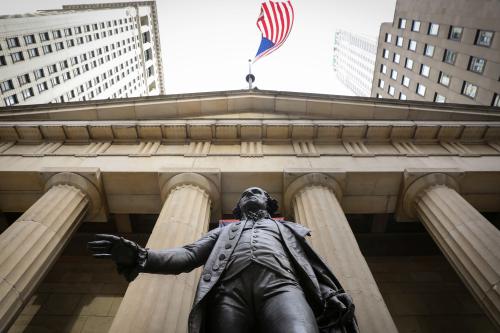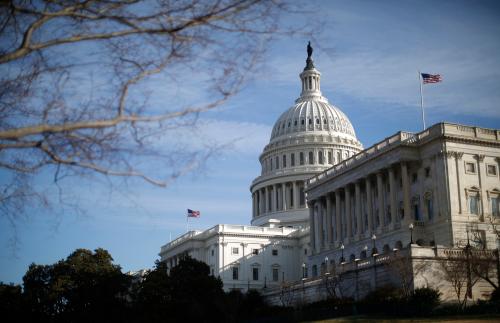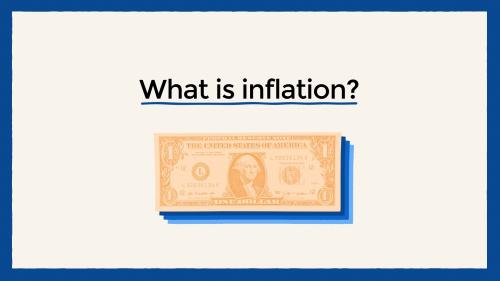This op-ed was original posted in the Washington Post.
Despite a strong economy, the U.S. budget deficit recently rose by nearly 40 percent year over year, largely because of the tax cuts passed in 2017 and the spending deal approved in 2018. Federal debt — the accumulation of past deficits — reached its highest level ever relative to the economy, with the exception of a few years around World War II. And that’s before financial shortfalls for Social Security and Medicare occur and send debt to unprecedented levels. Some conservatives warn of a coming debt crisis, while leading liberal economists argue that we can ignore deficits and debt at this time. Several myths are muddling the discussion.
MYTH NO. 1: Debt is harmless if it’s issued in a nation’s own currency.
In 2015, Nobel laureate Paul Krugman wrote that “because [public] debt is money we owe to ourselves, it does not directly make the economy poorer (and paying it off doesn’t make us richer).” Stephanie Kelton, a prominent advocate of modern monetary theory, says that “we should think of the government’s spending as self-financing since it pays its bills by sending new money into the economy.” In 2011, Warren Buffett said, “The United States is not going to have a debt crisis as long as we keep issuing our debts in our own currency.”
Yet in a recent University of Chicago survey of prominent economists, not one agreed that a country that issues debt in its own currency does not have to worry about deficits. Future debt will stem largely from anemic revenue growth and increased expenditures on an aging population. The result will reduce future national saving — the sum of saving by the private and public sectors — and drag down future national income. This could happen through higher interest rates, which choke off investment and reduce production and income. Or it could happen through greater borrowing from abroad, which would allow us to maintain production but siphon off increasing resources to debt payments. Estimates by the Congressional Budget Office and others indicate that these effects could be substantial. Politically, sustained deficits and rising long-term debt make it harder to garner support for new policies or to address the next recession, war or emergency.
MYTH NO. 2: Low interest rates mean debt doesn’t matter.
In a recent address to the American Economic Association, Olivier Blanchard, a former chief economist at the International Monetary Fund, said, “The signal sent by low [interest] rates is that not only debt may not have a substantial fiscal cost, but also that it may have limited welfare costs.” In Foreign Affairs, Jason Furman and Lawrence H. Summers wrote that low rates mean “policymakers should reconsider the traditional fiscal approach that has often wrong-headedly limited worthwhile investments.” Although these preeminent economists have been careful to qualify their statements, the popular discussion has sometimes jumped to the conclusion that low interest rates mean that deficits don’t matter.
Low interest rates certainly make debt more palatable and make the crisis scenarios look silly, but they are not a panacea. Under current law, the Congressional Budget Office projects that federal debt will rise from about 78 percent of gross domestic product (GDP) now to more than 150 percent by 2048 and will continue to increase afterward. Net interest payments are projected to rise from about 1.8 percent of GDP to more than 6 percent, which would be larger than the entire Social Security program.
Financial markets imply that low rates will persist, but have been wrong at times in the past. We can borrow and consume more if interest rates stay low forever, but if we accumulate a lot of debt and then rates rise, we will face major problems.
MYTH NO. 3: We should balance the budget and pay off the debt.
Centrist and conservative politicians and pundits constantly seek a balanced federal budget. Former senator Orrin G. Hatch (R-Utah) was called “Mr. Balanced Budget” because he sponsored or cosponsored legislation related to that goal more than 25 times . In 2018, columnist George Will wrote an op-ed for The Washington Post titled, “America needs a balanced-budget amendment.”
Balanced budgets may have symbolic value, but they are not necessary. Rules aimed at forcing balanced budgets make recessions deeper and longer by requiring spending cuts or tax increases during hard times, and they can be manipulated through accounting gimmicks. Almost every state has a balanced-budget rule, but many of them face future fiscal shortfalls focused on health-care and retirement spending, just as the federal government does.
An even more extreme goal is to pay off the entire debt. In 2016, Donald Trump said, “We’ve got to get rid of the $19 trillion in debt. . . . I think I could do it fairly quickly.” But paying off all debt makes no sense. As Alexander Hamilton explained, debt can be a blessing: It can facilitate trade, finance national defense, fight recessions, fund investments, and provide liquid and safe assets for investors. What we really need to do is put the debt on a stable and sustainable path. That will be hard enough.
MYTH NO. 4: We can grow our way out of the debt.
The Trump administration’s most recent budget projects average annual growth rates of 2.9 percent over the next decade, a reduction of the debt to 71 percent of GDP by 2029 and a balanced budget within 15 years, as a result of greater tax revenue.
Those figures, however, seem implausible. The CBO, the Federal Reserve and the Blue Chip forecasters all predict annual growth at 2 percent or below after this year, largely because of slowing labor force expansion. Using more realistic projections, the administration’s budget would actually yield a rising debt-to-GDP ratio. Faster economic growth could help lower debt, but the CBO estimates that raising productivity growth rates by one-third — an enormous boost — would slow the increase in the debt-to-GDP ratio over 30 years by only one-third.
In 1981, President Ronald Reagan’s tax cuts and defense spending put the nation on a rising debt path that took numerous bipartisan budget deals over 15 years to reverse. But now the debt-to-GDP ratio is three times as large as it was in 1981, and demographics are working against us: Baby boomers were entering the labor force and buying homes in the 1980s and 1990s, but they are retiring now, which will increase spending on Social Security and Medicare. Without policy changes, the budget won’t be able to avoid rising deficits and debt.
MYTH NO. 5: There’s an easy solution to the debt.
In his 2012 presidential campaign, Mitt Romney implied that he could tackle the debt in part by ending public television subsidies: “I like PBS. I love Big Bird. . . . But I’m not going to keep on spending money on things to borrow money from China to pay for it.” Much of the public has similar sentiments. As one voter told lawmakers in 2013, “Get rid of the deductions that don’t affect me.”
Any serious plan to lower the debt must involve significant tax increases and/or major spending cuts. Foreign aid, government salaries and other programs that politicians typically target are tiny, and eliminating them would not make much difference. Almost 70 percent of federal spending goes to Social Security, health care, defense and interest on the debt. Spending cuts will have to come from those areas. We can’t unilaterally cut interest payments — that’s called defaulting. And the other programs are extremely popular.
A second seemingly painless approach is to inflate away the debt. Trump once suggested to adviser Gary Cohn that the nation should “just run the presses — print money” to pay off the debt. This, of course, would lead to inflation. But most of our long-term obligations already are indexed to inflation, such as Social Security, Medicare and Medicaid payments. Inflation will not cut those costs.
The ultimate in pain-free solutions is the notion that broad-based tax cuts raise revenue. “Not only will this tax plan pay for itself, but it will pay down debt,” Treasury Secretary Steven Mnuchin said in 2017. But the record very clearly shows that broad tax cuts — such as those passed in 2017 — reduce revenue.







Commentary
Op-edFive myths about federal debt
May 2, 2019